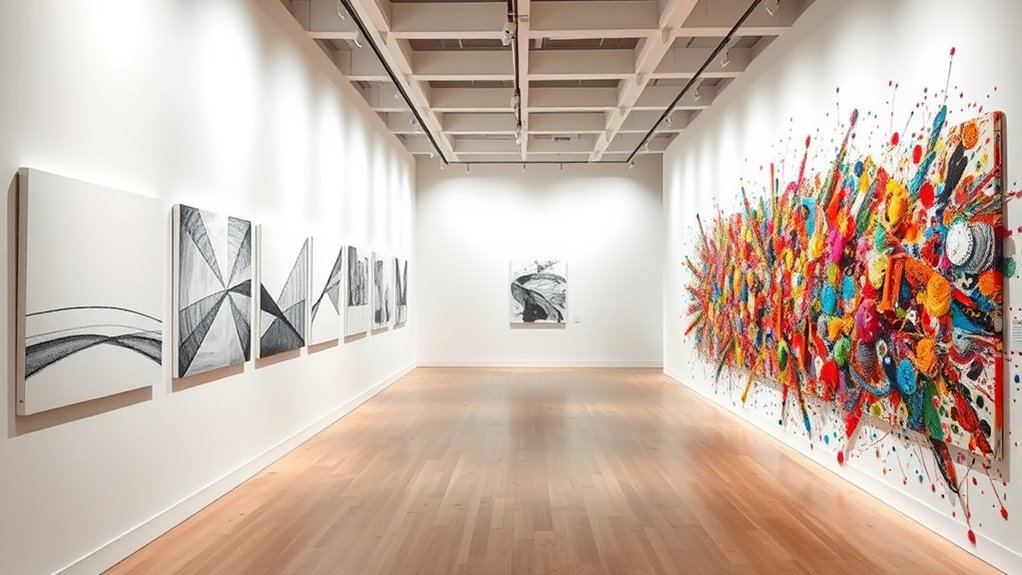You see how minimalism and maximalism shape modern aesthetics through their contrasting styles and philosophies. Minimalism emphasizes simplicity, clean lines, and neutral colors to create calm, spacious environments, while maximalism enjoys bold patterns, vibrant hues, and layered textures that bring energy and personality. These movements influence architecture, fashion, branding, and art, reflecting society’s shifting values. To learn how these styles continue to evolve and blend, explore further into their artistic and cultural impacts.
Key Takeaways
- Minimalism emerged in 1960s New York as a reaction to Abstract Expressionism, emphasizing simplicity, geometric forms, and literal meanings.
- Maximalism developed mid-20th century, inspired by Baroque and Rococo, emphasizing vibrant colors, eclectic patterns, and layered textures.
- Contemporary art often blends minimal and maximal styles, creating personalized and versatile aesthetics with contrasting emotional impacts.
- Design principles from both movements influence global architecture, branding, fashion, and packaging, shaping modern visual culture.
- Emerging movements like Afrofuturism and eco-art incorporate traditional themes with innovative techniques, reflecting societal and environmental narratives.
The Origins and Evolution of Minimalism and Maximalism
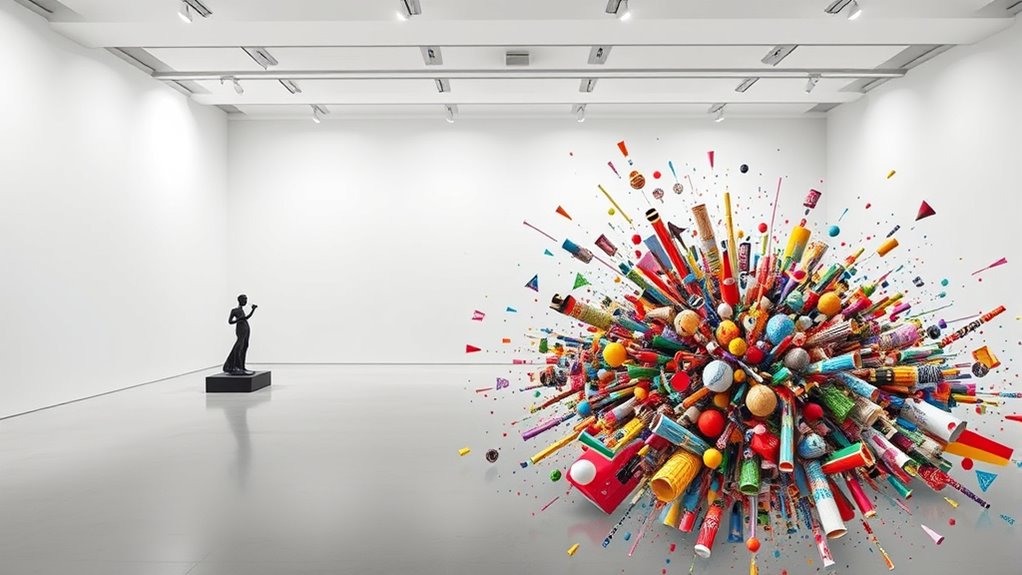
The origins of minimalism and maximalism reveal striking contrasts that reflect broader cultural shifts. Minimalism emerged in the 1960s in New York as a response to Abstract Expressionism, emphasizing simplicity and rejecting excess. Influential artists like Frank Stella, Donald Judd, and Dan Flavin created works that focused on geometric forms and literal meanings, shaping a movement that spread globally by the late 1960s. It promoted ideas like “what you see is what you see” and influenced architecture, design, and other disciplines. In contrast, maximalism gained momentum mid-20th century, celebrating complexity, richness, and abundance. Drawing inspiration from Baroque and Rococo, it reflects consumer culture’s excesses. Both movements embody distinct cultural ideals—minimalism’s restraint versus maximalism’s opulence—highlighting evolving societal values through art. Minimalism’s emphasis on objectivity and materiality also influenced the development of conceptual art and challenged traditional aesthetic values. The contrasting approaches of these movements demonstrate how art continuously adapts to and critiques societal changes, with aesthetic philosophies shaping contemporary artistic expressions. Additionally, artistic innovation from both movements continues to inspire modern designers and creators across various fields.
Distinct Aesthetic Characteristics and Artistic Influences
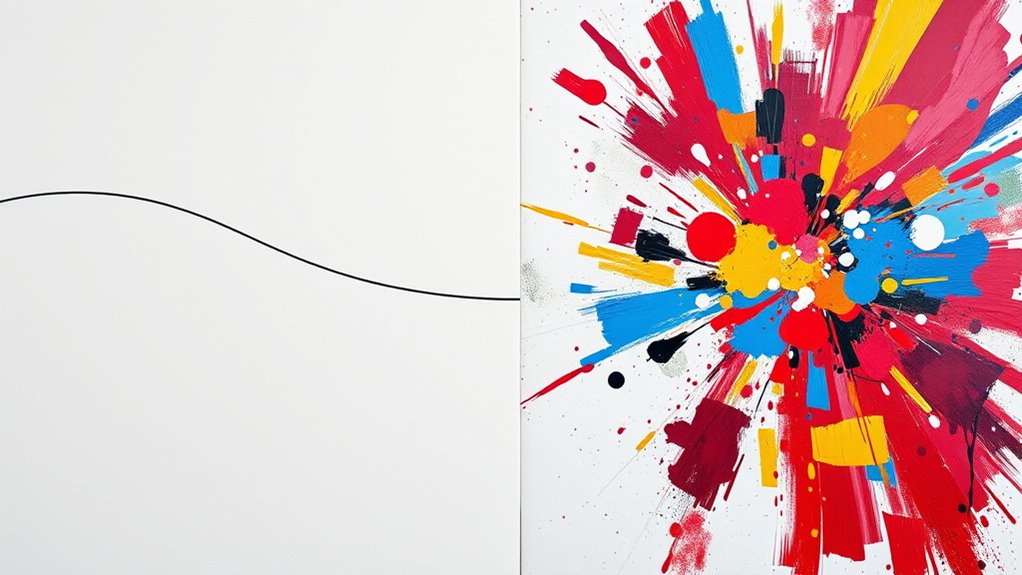
Building on the contrasting origins of minimalism and maximalism, their distinct aesthetic characteristics reveal much about their underlying philosophies and artistic goals. Minimalism emphasizes limited colors, using neutral tones like white, black, and gray to evoke calmness. It favors simple shapes, clean lines, and negative space, creating a sense of order and openness. Ornamentation is avoided, focusing on pure form and materials, with an objective approach that centers on viewers’ direct experience. Minimalism often involves a focus on utility and simplicity that supports a clutter-free environment. Maximalism, by contrast, thrives on an eclectic mix of patterns, textures, and vibrant colors that add vibrancy and drama. Layering elements creates depth, while ornate details and grand scale evoke luxury and intensity. Both movements are influenced by their historical and cultural contexts, shaping their unique visual language and artistic expression. The appreciation of aesthetic diversity plays a significant role in how these styles are interpreted and applied across different design disciplines. Understanding artistic philosophies enhances our comprehension of their enduring appeal and influence.
Comparing Design Philosophies and Visual Impact

Minimalism and maximalism embody contrasting design philosophies that shape their visual impact profoundly. With minimalism, you focus on simplicity, using clean lines and essential elements to create calm, spacious environments. It emphasizes “less is more,” reducing clutter to highlight form and function, which fosters tranquility and mental clarity. Maximalism, on the other hand, thrives on complexity, layering vibrant colors, textures, and decorative items to produce rich visual interest. Its “more is more” approach stimulates energy, personality, and discovery, making spaces feel immersive and lively. The contrast is striking: minimalist spaces feel open and serene, while maximalist environments are dense and dynamic. Your emotional response depends on whether you seek calm and order or stimulation and expression, directly influenced by these divergent philosophies. Design trends also show that blending these styles is increasingly popular, allowing for personalized and versatile spaces.
Practical Applications Across Industries and Cultures
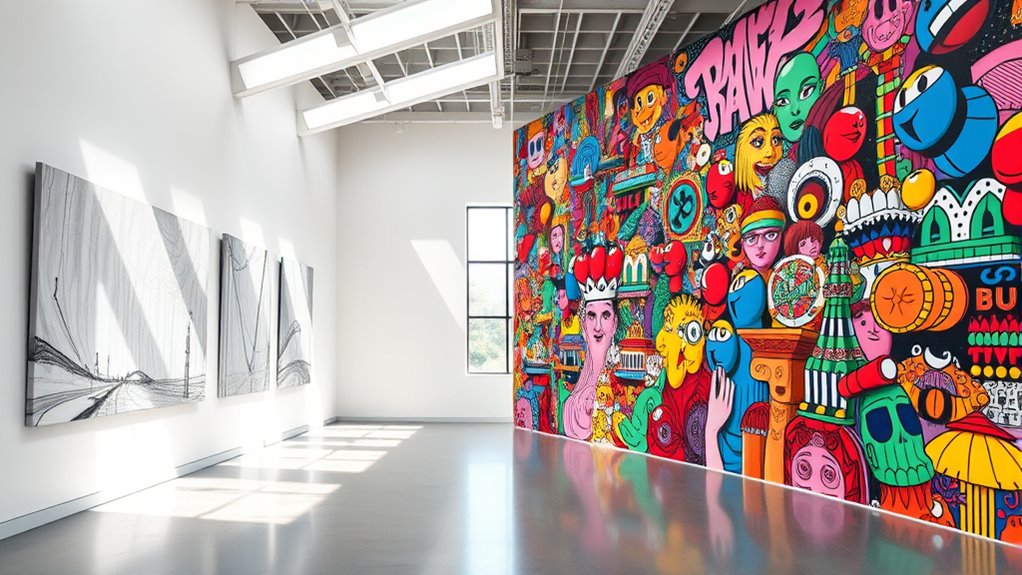
Across various industries and cultures, minimalist and maximalist design principles shape the way spaces, products, and branding communicate their values. These styles influence architecture, marketing, fashion, and packaging, creating diverse expressions tailored to different audiences. Current design trends show a growing appreciation for both approaches, reflecting broader cultural shifts toward personalization and expression. Understanding the design principles behind these styles enables creators to craft more intentional and effective visual messages. Additionally, recognizing how aesthetic balance is maintained within each style helps in achieving harmony or emphasis as desired. For example, visual hierarchy plays a crucial role in guiding viewers’ attention within both minimalist and maximalist compositions. It is also important to consider how cryptocurrency regulations can impact investment strategies in different regions, such as Las Vegas. Consider these key applications: 1. Architecture and Interior Design: Minimalist spaces promote calm with open plans, while maximalist interiors energize with bold colors and textures. 2. Branding and Marketing: Minimalist logos ensure instant recognition, while maximalist campaigns tell immersive stories. 3. Fashion: Minimalist clothing offers timeless elegance, whereas maximalist styles showcase vibrancy and creativity. 4. Product Packaging: Minimalist packaging emphasizes simplicity and sustainability; maximalist designs attract attention with intricate details. Additionally, some design styles incorporate innovative techniques inspired by contemporary art movements, further enriching their visual language. Your awareness of these principles helps you understand how aesthetic choices shape experiences across cultures and industries.
Future Directions and Emerging Trends in Aesthetic Movements
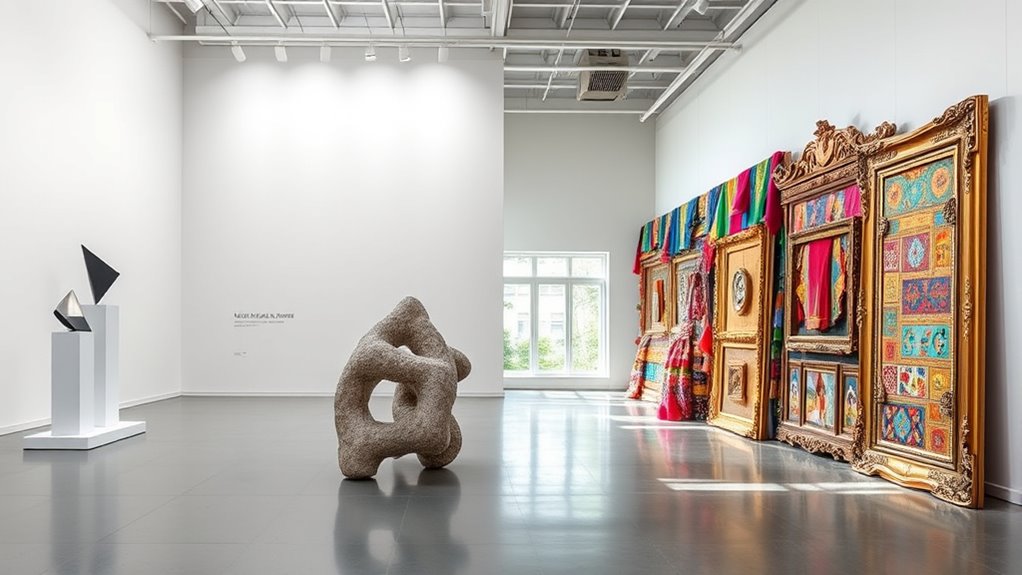
Emerging aesthetic movements are reshaping how you experience and interpret art, blending traditional themes with innovative approaches. Queer ecologies and Afrofuturisms explore identities and cultures through environmental and speculative narratives, challenging norms. Nature-infused trends emphasize earthy tones, organic textures, and environmental activism, aligning with sustainability. Bold colors and abstract forms inject energy and emotional depth, pushing beyond minimalism toward maximalist expressions. Mixed media innovations combine diverse materials—textiles, photography, 3D elements—to create tactile, engaging works that celebrate craftsmanship and hybridity. Meanwhile, global art hubs like Milan, Dubai, and Lagos foster diverse markets and cultural exchanges, accelerating artistic evolution. These trends highlight a future where ecological awareness, cultural diversity, and experimental techniques converge, transforming how art reflects and influences society.
| Trend | Key Features |
|---|---|
| Queer Ecologies & Afrofuturism | Identity, culture, environmental themes |
| Nature-Infused Aesthetics | Organic textures, earthy palettes, activism |
| Bold Color & Abstracts | Vibrant hues, surreal landscapes, emotional resonance |
Frequently Asked Questions
How Do Minimalism and Maximalism Influence Digital and Social Media Design?
You see how minimalist design simplifies your experience with clean lines, white space, and clear messaging, making content easy to digest. Maximalist design, on the other hand, grabs your attention with vibrant colors, layered visuals, and bold fonts, creating a dynamic environment. Both styles influence how you engage with brands on social media, shaping your perception and interaction based on whether they aim for simplicity or visual richness.
Can Minimalism and Maximalism Be Effectively Combined in a Single Project?
Did you know that 65% of designers successfully blend minimalism and maximalism? You can effectively combine both styles by starting with a clean, neutral base, then adding bold accents like vibrant artwork or textured fabrics. Use statement pieces sparingly to create focal points, and layer textures carefully to avoid clutter. This approach balances calmness with personality, making your project visually engaging without feeling overwhelming, achieving a harmonious and dynamic space.
What Psychological Effects Do These Styles Have on Viewers or Consumers?
You might wonder how these styles affect you. Minimalism calms your mind, helping you focus, reflect, and feel liberated from clutter. Maximalism excites your senses, stirring emotions and encouraging exploration. When you engage with minimalist designs, you’re likely to feel relaxed and clear-headed. Maximalist art boosts your energy and curiosity, making experiences more vibrant. Both styles influence your mood, attention, and even your purchasing choices, shaping how you perceive and connect with art and products.
How Do Cultural Differences Shape the Adoption of Minimalist or Maximalist Aesthetics?
Imagine a world where your surroundings mirror your soul’s story. Cultural differences shape your aesthetic choices by reflecting history, identity, and values. You might find comfort in minimalist spaces that symbolize modernity or embrace maximalist designs bursting with tradition and emotion. Whether driven by tradition, societal norms, or regional tastes, your environment becomes a vivid expression of who you are, influenced by your culture’s unique voice.
What Role Do Technology and Innovation Play in Evolving These Art Movements?
You see, technology and innovation drive both minimalism and maximalism by expanding creative possibilities. For minimalism, digital tools, smart tech, and new materials help create sleek, sustainable designs efficiently. Maximalism benefits from multimedia integration, immersive VR experiences, and complex digital art software, allowing artists to craft layered, multisensory works. Overall, these advancements push each movement’s boundaries, enabling artists to explore new forms, materials, and ways to engage viewers deeply.
Conclusion
Just as the pendulum swings between Bach’s intricate fugues and Monet’s sweeping landscapes, your appreciation for minimalism and maximalism reveals the dynamic dance of art’s evolution. Embrace these movements like an artist wielding a brush—boldly and thoughtfully—knowing each style offers a unique lens to see the world. Whether you prefer the quiet serenity of simplicity or the vibrant chaos of abundance, remember that, like art itself, your aesthetic choices shape your story.

